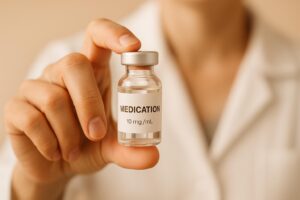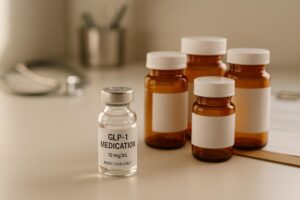Understanding the Side Effects of GLP-1 Drugs

Introduction
Did you know that over 70% of Americans are considered to be overweight or obese? With such alarming statistics, it’s no wonder that weight loss solutions are in high demand. Among these solutions are GLP-1 drugs, a class of medications that have garnered significant attention for their effectiveness in managing weight and controlling blood sugar levels in individuals with type 2 diabetes. However, as with any medication, understanding the potential side effects is crucial for anyone considering these treatments.
GLP-1 drugs, or glucagon-like peptide-1 receptor agonists, are designed to mimic the effects of a naturally occurring hormone that plays a vital role in appetite regulation and glucose metabolism. While these medications can provide significant benefits, they also come with a range of side effects that can affect individuals differently. In this blog post, we will explore the various side effects associated with GLP-1 drugs, providing insights into their implications and management strategies, and how they align with the values of TrimRx—where we’re dedicated to offering personalized weight loss solutions backed by clinical evidence.
By the end of this article, you will gain a comprehensive understanding of what to expect when using GLP-1 drugs, how to manage potential side effects, and the importance of a personalized approach to weight loss. Let’s embark on this journey together to uncover the nuances of GLP-1 medications and their effects on our health.
What are GLP-1 Drugs?
GLP-1 drugs are a class of medications that act as receptor agonists for glucagon-like peptide-1, a hormone that is naturally produced in the intestines. This hormone is released when we consume food, stimulating insulin secretion and reducing appetite. GLP-1 drugs have become increasingly popular due to their dual action: they help control blood sugar levels in people with type 2 diabetes while also promoting weight loss.
These medications work in several ways:
- Stimulating insulin release: GLP-1 drugs encourage the pancreas to produce more insulin when blood sugar levels are high, thereby helping to lower blood glucose.
- Suppressing glucagon: They reduce the secretion of glucagon, a hormone that raises blood sugar by promoting glucose release from the liver.
- Delaying gastric emptying: By slowing the rate at which food leaves the stomach, GLP-1 medications can enhance feelings of fullness and reduce appetite.
The FDA has approved several GLP-1 medications, including semaglutide (Ozempic® and Wegovy®), liraglutide (Victoza® and Saxenda®), and tirzepatide (Mounjaro®), among others. Each drug may have different dosing regimens and indications for use, but they all share these core mechanisms of action.
Common Side Effects of GLP-1 Drugs
While GLP-1 drugs can be effective in managing weight and blood sugar, they are not without their side effects. Understanding these potential side effects is essential for anyone considering these medications. Let’s explore the most common side effects associated with GLP-1 drugs:
1. Gastrointestinal Symptoms
Gastrointestinal issues are among the most frequently reported side effects of GLP-1 drugs. These may include:
- Nausea: This is often the most common side effect, with studies suggesting that up to 50% of patients may experience it, particularly when starting the medication or increasing the dose.
- Vomiting: Some individuals may experience vomiting, especially if they are unable to tolerate the nausea.
- Diarrhea and Constipation: These symptoms can occur as the body adjusts to the medication, leading to fluctuations in digestive regularity.
Managing these symptoms often involves dietary modifications, such as eating smaller, more frequent meals or avoiding greasy and spicy foods. Staying hydrated is also crucial, as it can help mitigate nausea and promote digestive health.
2. “Ozempic Face”
One term that has gained attention in popular media is “Ozempic face.” This phenomenon refers to the cosmetic changes some individuals experience after rapid weight loss associated with GLP-1 medications. As weight is lost quickly, the face may appear hollow or sagging due to fat loss in the cheeks and around the jawline. While this is not a direct side effect of the medication, it is a consequence of rapid weight loss, which can be exacerbated by any weight loss regimen.
To manage these cosmetic effects, individuals may consider gradual weight loss strategies or consult with healthcare providers about potential treatments to address skin elasticity and appearance.
3. Low Blood Sugar (Hypoglycemia)
While GLP-1 drugs are less likely to cause hypoglycemia compared to other diabetes medications, it can still occur, particularly if used in conjunction with medications that lower blood sugar, such as insulin or sulfonylureas. Symptoms of hypoglycemia include:
- Sweating
- Shakiness
- Confusion
- Dizziness
If experiencing symptoms of low blood sugar, individuals should consume quick sources of glucose, such as fruit juice or glucose tablets, and consult their healthcare provider for guidance on managing their medication regimen.
4. Injection Site Reactions
For those using injectable GLP-1 medications, injection site reactions may occur. These can include redness, swelling, or itching at the injection site. Most reactions are mild and resolve on their own. However, if they persist or worsen, it is advisable to contact a healthcare professional.
5. Pancreatitis
Although rare, there have been reports of pancreatitis associated with GLP-1 drug use. Symptoms of pancreatitis can include:
- Severe abdominal pain
- Nausea and vomiting
- Fever
If experiencing these symptoms, it is crucial to seek medical attention promptly. Regular monitoring of pancreatic enzyme levels may also be recommended by healthcare providers to ensure safety while on GLP-1 medications.
6. Other Potential Side Effects
In addition to the above, GLP-1 drugs may also be associated with:
- Headaches
- Fatigue
- Gastroesophageal reflux disease (GERD)
- Increased heart rate
As with any medication, the potential benefits must be weighed against these side effects. A healthcare provider can help determine the best course of action based on individual health conditions and treatment goals.
Managing Side Effects
Understanding how to manage side effects effectively can greatly enhance the experience of using GLP-1 drugs. Here are some strategies for managing the common side effects mentioned:
Gastrointestinal Symptoms
- Start Low and Go Slow: If new to GLP-1 drugs, starting at a lower dose and gradually increasing it can help minimize gastrointestinal discomfort.
- Dietary Modifications: Eating smaller meals, avoiding high-fat and high-sugar foods, and incorporating more fiber can aid in digestive health.
- Stay Hydrated: Drinking plenty of fluids can help alleviate nausea and support overall digestion.
Cosmetic Changes (“Ozempic Face”)
- Gradual Weight Loss: If concerned about cosmetic changes, a slower approach to weight loss might be advisable.
- Skincare and Treatments: Using skincare products that promote collagen production and consulting professionals about cosmetic procedures can help address sagging skin.
Hypoglycemia
- Regular Monitoring: For individuals taking other blood sugar-lowering medications, regularly monitoring blood sugar levels can help prevent episodes of hypoglycemia.
- Educate Yourself: Knowing the symptoms of low blood sugar and having quick remedies on hand—such as glucose tablets—can be lifesaving.
Injection Site Reactions
- Change Injection Sites: Rotating injection sites can help minimize irritation and reactions.
- Proper Technique: Ensuring proper injection technique can reduce the likelihood of site reactions.
Pancreatitis
- Awareness of Symptoms: Knowing the signs of pancreatitis and seeking immediate medical attention if they occur is crucial.
- Regular Check-ups: Routine check-ups can help monitor pancreatic health during treatment.
When to Consult a Healthcare Provider
Understanding when to seek medical advice while taking GLP-1 drugs is essential for ensuring safety and efficacy. You should consult your healthcare provider if you experience:
- Severe or persistent gastrointestinal symptoms
- Signs of pancreatitis (e.g., severe abdominal pain)
- Symptoms of an allergic reaction (e.g., rash, difficulty breathing)
- Unexplained weight loss or significant changes in appetite
Your healthcare provider can help assess your situation and determine the best course of action, whether it involves adjusting your medication, implementing supportive measures, or exploring alternative treatments.
TrimRx’s Personalized Approach to Weight Loss
At TrimRx, we understand that every individual’s weight loss journey is unique. Our personalized weight loss programs are designed to provide medically supervised care tailored to each person’s specific needs and goals. We emphasize a comprehensive approach that includes:
- Doctor consultations
- Lab work to assess overall health
- Unlimited support throughout your journey
- Medications sourced from FDA-registered pharmacies, ensuring safety and quality
If you’re considering GLP-1 medications as part of your weight loss journey, we encourage you to take our free assessment quiz to determine your eligibility for prescription weight loss medications. By understanding your individual health profile, we can create a personalized treatment plan that aligns with your goals, all while prioritizing your safety and well-being.
Take our free assessment quiz today!
Additionally, we offer quick-access supplements, such as GLP-1 Daily Support and Weight Loss Boost, to support your overall wellness during your weight loss journey.
Conclusion
GLP-1 drugs offer an innovative approach to managing weight and blood sugar levels, but they are not without their challenges. Understanding the potential side effects and how to manage them is crucial for anyone considering these medications. With proper education and support, individuals can navigate the complexities of GLP-1 treatment and achieve their weight loss goals safely and effectively.
At TrimRx, we are committed to providing compassionate care that respects each individual’s unique journey. We believe that sustainable weight loss should be achieved through science, empathy, and a transparent approach. If you’re ready to take the next step in your weight loss journey, we invite you to connect with us and explore how our personalized programs can help you succeed.
FAQ
What are GLP-1 drugs?
A: GLP-1 drugs are medications that mimic the hormone glucagon-like peptide-1, which helps regulate blood sugar levels and appetite. They are commonly used for managing type 2 diabetes and promoting weight loss.
What are the common side effects of GLP-1 drugs?
A: Common side effects include gastrointestinal issues (nausea, vomiting, diarrhea), injection site reactions, low blood sugar (hypoglycemia), and cosmetic changes like “Ozempic face.”
How can I manage the side effects of GLP-1 drugs?
A: Managing side effects can involve dietary modifications, gradual increases in dosage, staying hydrated, and consulting with healthcare providers about any persistent symptoms.
When should I contact my healthcare provider while on GLP-1 medication?
A: You should seek medical advice if you experience severe gastrointestinal symptoms, signs of pancreatitis, or any severe allergic reactions.
How can TrimRx help me with my weight loss journey?
A: TrimRx offers personalized weight loss solutions, including doctor consultations, medications, lab work, and ongoing support to help you achieve your weight loss goals safely and effectively.

Transforming Lives, One Step at a Time
Keep reading
Ultimate Guide to Semaglutide Dose Customization
This guide explores semaglutide dosing for diabetes and weight loss, emphasizing personalized adjustments for optimal results.
6 Common Drug Interactions with GLP-1 Medications
Learn about six common drug interactions with GLP-1 medications and how to manage potential risks for safe treatment.
Mounjaro Insurance Coverage: What to Know
Learn how insurance coverage for Mounjaro varies based on diabetes treatment and weight loss, along with tips for approval and cost-saving options.
Semaglutide vs. Tirzepatide: Max Dose
Explore the differences between two weight loss medications, their maximum doses, effectiveness, and safety profiles for better health outcomes.
GLP-1 Diet Plan: 7-Day Meal Guide
Learn how to effectively pair GLP-1 medications with nutritious meal planning for weight loss, improved digestion, and stable blood sugar.
Nausea and GLP-1 Medications: Solutions That Work
Learn effective strategies to manage nausea from GLP-1 medications, including dietary tips and the importance of personalized dosing.
5 Signs GLP-1 Medication Is Working for You
Learn the key signs that indicate your GLP-1 medication is effectively aiding weight loss, appetite control, and blood sugar management.
Plateau Problems: Restarting Weight Loss
Stalled weight loss on GLP-1 medications is common but manageable. Explore strategies to break through plateaus and regain momentum.
Body Fat Percentage Estimator – Know Your Stats
Estimate your body fat percentage in seconds with our free tool. Just input your height, weight, and more for instant results. Try it now!









